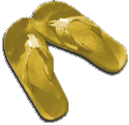Art’s attempt to integrate evil
When you see a rainbow, do you think of refraction and separated wave lengths of color, or do you wonder at the mystery of God’s promise in Genesis about the sign of a covenant? Perhaps you dream about a pot of gold and Irish luck?
When you gaze at Michelangelo's statue of David or his Sistine ceiling painting The Creation of Man, do you ponder the reality of truth and the existence of good and evil in our world? Simone de Beauvoir said, “Art is an attempt to integrate evil.” Art plays a significant role in exploring the darker aspects of our world.
Think of the difference between a Playboy center fold and Michelangelo's sculpture David. The way that art gives pleasure in beauty is not always readily clear. Michelangelo confronts the struggle between good and evil head on in The Last Judgement which portrays over three hundred figures, mostly nude, ascending or descending to their fate.
In our reality the boundary between good and evil is often blurred. By presenting both in stark images an artist enables us to recognize uncertainties like doubt and mystery, what John Keats called “negative capability.” We may behold “beauty, perfection and sublimity” while holding “thoughts of confusion and uncertainty without any irritable reaching after fact and reason,” Keats said.
“Beauty is truth, truth beauty,” Keats said in “Ode on a Grecian Urn.” Art depicts truth. “The aim of art is to represent not the outward appearance of things, but the inward significance.” (Aristotle).
The conflict of good versus evil in art includes varied subject matter. In 1541, under Pope Pius V, Michaelangelo’s The Last Judgement underwent a discreet drapery of some of the controversial nudity. Some restorations of the painting took place in 1980 to 1994.
Francisco Goya’s “The Disasters of War” or the dark melodies of composers like Dmitri Shostakovich showcase the horrors of war and highlight humanity’s capacity for destruction. Viewers and listeners are forced to confront the evil that permeates our world.
In the concept of dualism, in philosophy, the world includes opposing forces or principles like good and evil or light and dark. Art can create a bridge connecting these opposites, placing them side by side for a more inclusive view of reality. Art offers a canvas where evil can be examined.
Simone de Beauvoir’s quote, “Art is an attempt to integrate evil,” reminds us to recognize the existence of evil rather than ignoring it. A greater consciousness and understanding of the world may result. Acknowledging the existence of evil enables us to deal with it in a more constructive way.
Art helps us better understand the human condition. The awareness of evil enables us to grapple with it. A collective awareness can inspire change, compassion and empathy. Take for example Goya’s The Disasters of War, Holocaust art, or The Diary of Anne Frank.
Tens of millions have been impacted by the story of Anne Frank. This German-Jewish girl spent over two years hiding for her life in Holland. Anne wrote letters to imaginary friends that reflected her courage and literary skills in the face of great adversity.
“In spite of everything, people are truly good and honest at heart,” she wrote. After more than two years of hiding in an attic the eight members of the group were captured. Only Anne’s father survived. Anne died of typhus in Bergen-Belsen in March 1945 at the age of fifteen.
Thanks to Quote Meanings 2 for ideas)
581 words)

